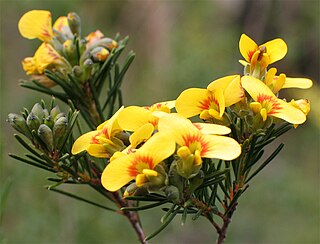
Dillwynia is a genus of about 20 species of flowering plants in the family Fabaceae, and is endemic to Australia. Plants in this genus are shrubs with simple leaves and yellow or red and yellow flowers similar to others in the family.

Dillwynia tenuifolia is a species of flowering plant in the family Fabaceae and is endemic to eastern New South Wales. It is an erect shrub with linear leaves, and orange-yellow and red flowers.

Dillwynia glaberrima, the smooth parrot-pea, is a plant in the pea family, Fabaceae, native to Australia.
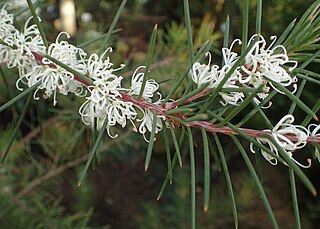
Hakea sericea, commonly known as bushy needlewood or silky hakea, is a large shrub with a profusion of mainly white flowers from July for several months. It is endemic to eastern Australia. It has become an environmental weed in some countries.

Pultenaea daphnoides, commonly known as large-leaf bush-pea or large-leaf bitter-pea, is a species of flowering plant in the family Fabaceae and is endemic to south-eastern Australia. It is an erect shrub with egg-shaped to wedge-shaped leaves with a pointed tip, and dense clusters of bright yellow and red flowers.

Dillwynia cinerascens, commonly known as grey parrot-pea, is a species of flowering plant in the family Fabaceae and is endemic to south-eastern Australia. It is an erect to low-lying shrub with linear or thread-like leaves and orange or yellow flowers.
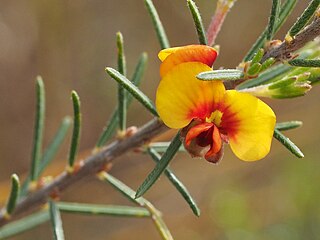
Dillwynia sericea, commonly known as showy parrot-pea, is a species of flowering plant in the family Fabaceae and is endemic to south-eastern Australia. It is an erect to low-lying shrub with hairy stems, linear leaves and apricot-coloured flowers, usually with a red centre.

Dillwynia floribunda is a species of flowering plant in the family Fabaceae and is endemic to eastern Australia. It is an erect shrub with hairy stems, crowded, grooved, linear leaves and yellow flowers with red markings.
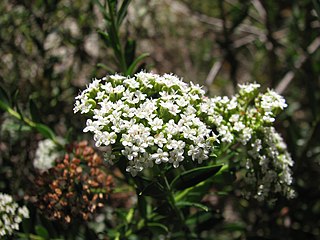
Platysace lanceolata, commonly known as shrubby platysace, is a flowering plant in the family Apiaceae and is endemic to south-eastern Australia. It is small, upright shrub with variable shaped leaves and white flowers.
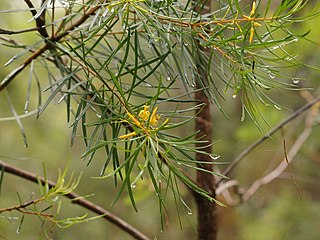
Persoonia virgata is a species of flowering plant in the family Proteaceae and is endemic to coastal areas of eastern Australia. It is usually an erect shrub with smooth bark, hairy young branchlets, linear to narrow spatula-shaped leaves, and yellow flowers borne in groups of up to seventy-five on a rachis up to 230 mm (9.1 in) long that continues to grow after flowering.
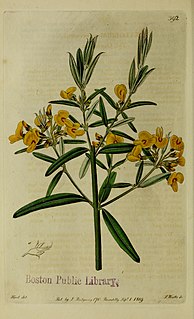
Oxylobium arborescens, commonly known as the tall shaggy-pea, is a species of flowering shrub to small tree in the family Fabaceae and is endemic to south-eastern Australia. It has elliptic dark green leaves and yellow pea flowers.

Petrophile pulchella, commonly known as conesticks, is a common shrub of the family Proteaceae and is found in eastern Australia. The leaves are divided with needle-shaped but soft pinnae, the flowers silky-hairy, cream-coloured and arranged in oval heads and the fruit are arranged in oval heads. Conesticks grows on shallow sandstone soils, often in open forest or heathlands near the coast. It is also occasionally seen on the adjacent ranges.
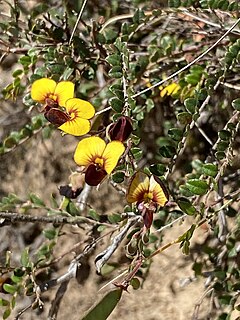
Bossiaea prostrata, commonly known as creeping bossiaea, is a prostrate understory shrub in the pea family, Fabaceae. It is a widespread species with orange-yellow flowers, purple-brown keels and trailing branches.
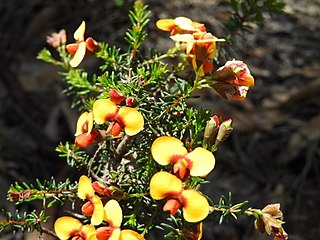
Dillwynia phylicoides, commonly known as small-leaf parrot-pea, is a species of flowering plant in the family Fabaceae and is endemic to eastern Australia. It is an erect to open shrub with twisted, linear to narrow oblong leaves, and yellow and red flowers.

Hovea longifolia commonly known as rusty pods, is a flowering plant in the family Fabaceae, endemic to eastern Australia. It has purple pea flowers, linear leaves with rusty felt like hairs on the lower surface.

Dillwynia brunioides, commonly known as sandstone parrot-pea, is a species of flowering plant in the family Fabaceae and is endemic to New South Wales. It is an erect shrub with silky-hairy stems, linear, grooved leaves and yellow flowers with red markings.
Dillwynia dillwynioides is a species of flowering plant in the family Fabaceae and is endemic to the south-west of Western Australia. It is a low-lying or erect, spindly shrub with cylindrical, grooved leaves and yellow, red or orange flowers with yellow, red or orange markings.
Dillwynia juniperina, commonly known as prickly parrotpea, is a species of flowering plant in the family Fabaceae and is endemic to south-eastern continental Australia. It is an erect, spreading shrub with rigid, linear, sharply-pointed leaves and yellow flowers with red markings.
Dillwynia parvifolia is a species of flowering plant in the family Fabaceae and is endemic to New South Wales. It is a spreading to erect shrub with twisted, narrow oblong leaves and yellow flowers with red markings.
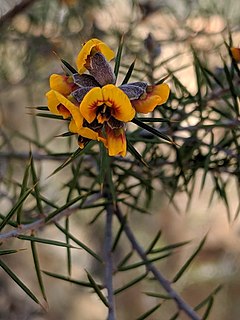
Dillwynia sieberi, commonly known as Sieber's parrot-pea, is a species of flowering plant in the family Fabaceae and is endemic to eastern Australia. It is an erect shrub with rigid, needle-shaped, sharply-pointed leaves and yellow to yellow-orange flowers with reddish-brown markings.

















